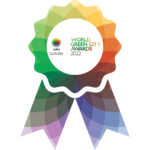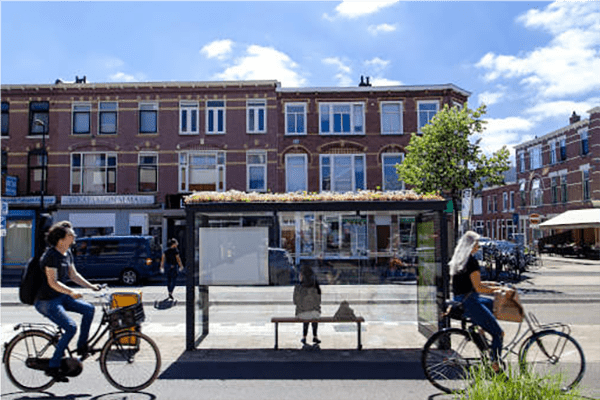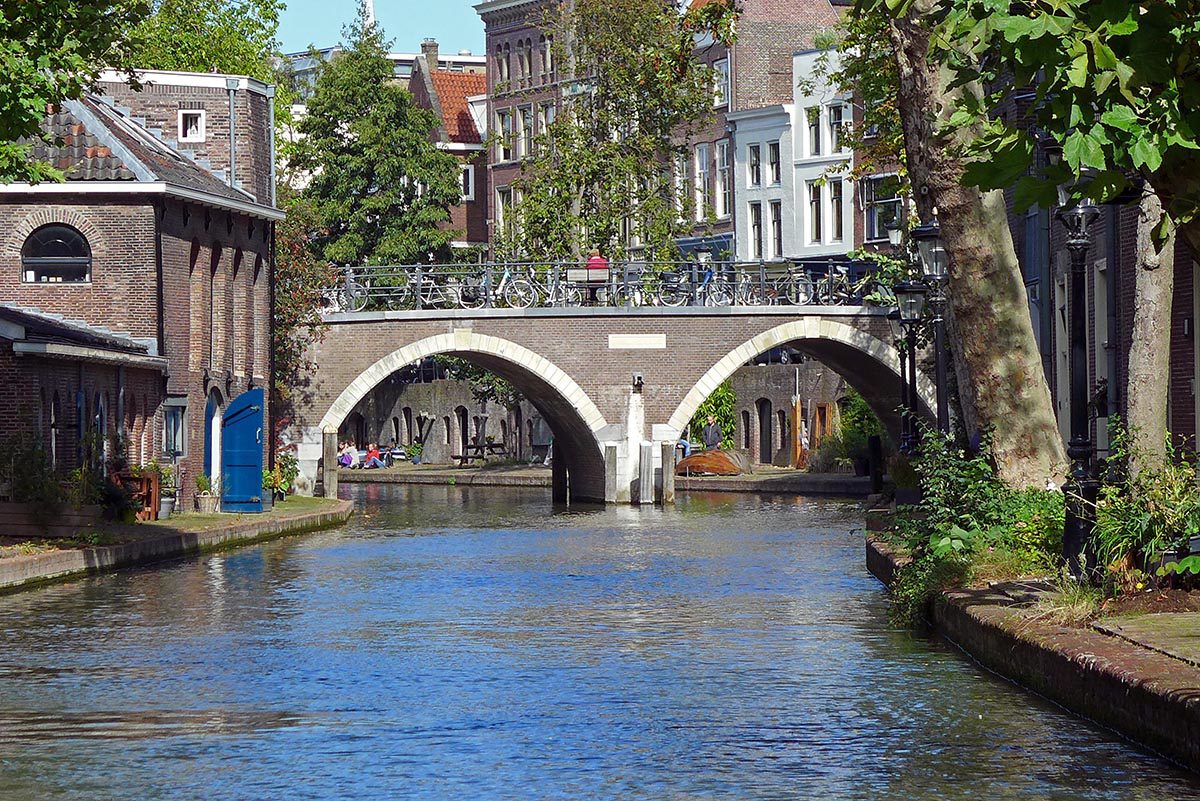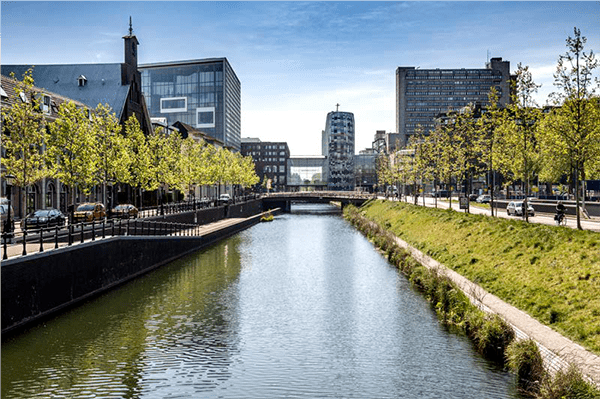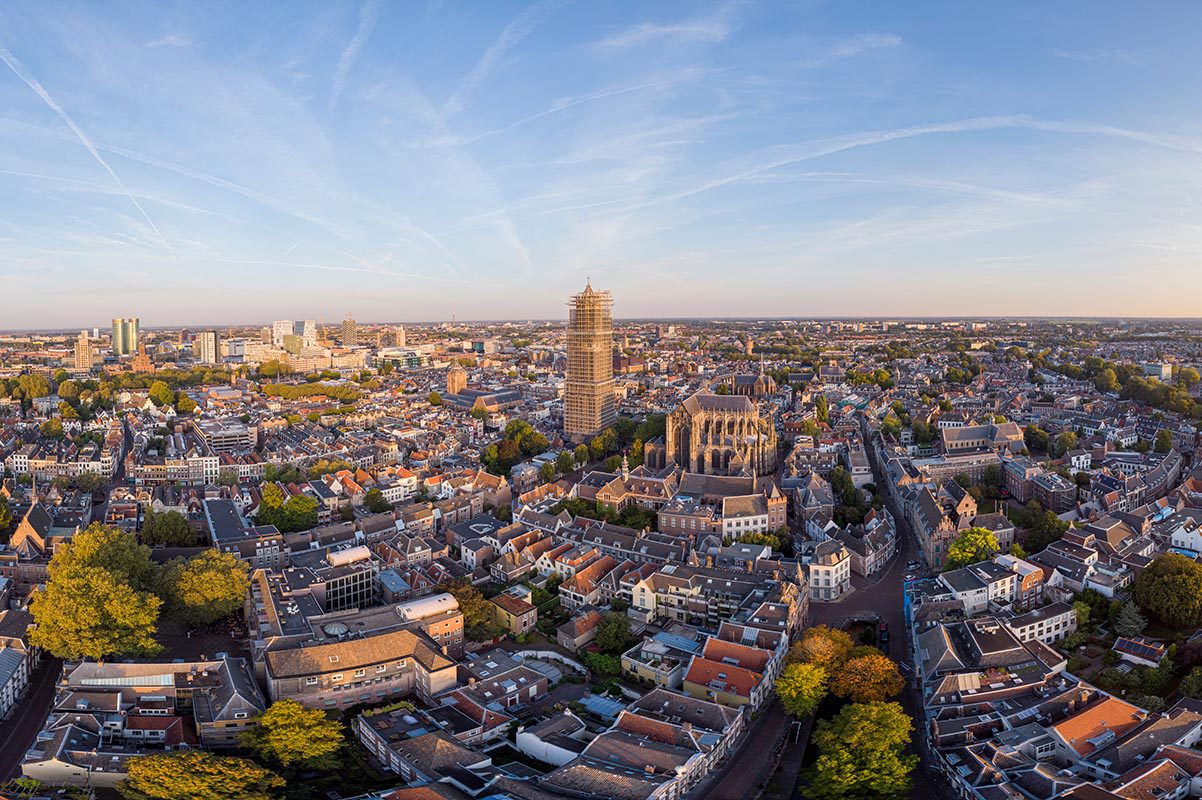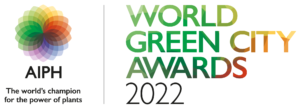Addressing the urban challenge
Breadth of the issue – How are the problem(s) that are being tackled by your initiative affecting citizens/local businesses or a significant component of the local wildlife?
Since the construction of the shopping mall Hoog Catharijne in the 70’s, the pressure on the historic city centre has increased significantly: the number of inhabitants has been growing rapidly for years, more and more people take the train, bike and car and Utrecht Central Station was too small for the number of travellers. The old station area was suffering from overdue maintenance and dilapidation and there was a long-cherished desire to get the water back in the canal. The construction of the new Central Station area has and will address all these issues simultaneously.
The Central Station area has a very poor air-quality (see page 40 https://www.utrecht.nl/bestuur-en-organisatie/publicaties/onderzoek-en-cijfers/onderzoek-over-utrecht/duurzaamheidsverslag/). Reducing car-traffic and stimulating healthy means of transportation will add to the life expectancy of people in this area.
Depth of the issue – How seriously are the problems being tackled by your initiative impacting the life of the citizens/businesses/wildlife concerned?
In the 70s, the Canal, which encircled the inner city of Utrecht, has been concreted to make room for a 12-lane motorway, but after years of demolition, construction and digging, that “mistake” has now been corrected. The inner city of Utrecht is, once again, surrounded by water and greenery. This is a historic development for our city. The Utrecht canal together with the bridges, the neighbouring greenery, the monuments and historic remains on both sides of the canal are a monument, which spans nearly 900 years. With the restoration of the last section of the canal, the canal is finally whole again, and another chapter has been added to its history.
The best part of this enormous project is the way in which residents have been involved from the beginning, starting with a referendum on the future of the canal in 2001, when residents massively voted for the return of the entire canal. Now, after 20 years, with heavy involvement from our residents, the canal zone crossing the station area has been transformed from a large polluting motorway into a waterway that functions as a green and healthy pathway from the station into the city centre.
The power of plants and natural ecosystems to deliver benefits
How is the initiative shaped by scientific evidence of the potential for plants and natural ecosystems to deliver benefits?
Healthy Urban Living is the motto with which we create our city. Green is an essential part of the environmental and human health (https://www.sciencedirect.com/science/article/abs/pii/S0272494402001111)
When designing and adapting the city, we opt for greenery as much as possible, and as little as possible tiles or asphalt. We use facades and roofs for greenery. We try to ensure as much continuous greenery as possible and create green routes that allow animals and plants to reach new habitats. We opt for plants that grow here naturally, and which can also cope with the future climate.
For Wonderwoods, an appartement building with trees on the facades and on the roofs, the inspiration for indigenous trees and plants came from the nearby Utrechtse Heuvelrug (a national natural park). As known from scientific evidence local plants are essential for local insects and other animals (https://www.wur.nl/nl/show/de-ene-boom-is-de-andere-niet.htm)
How has the city exploited the potential of plants and associated ecosystems to deliver more than one benefit?
We are connecting the city and the surrounding natural landscape. This way our citizens can enjoy the green surroundings (and mentally recover the busy urban life) and the plants and animals from the natural and recreational parks can renature our city. This also gives endangered plant and animals species more room to live. By bringing nature back into the heart of our city, it also will bring our citizens more into contact with nature.
Greening our city also helps in mitigating the negative effects of climate change, such as the urban heat island effect, and the more frequently occurring heavy rain showers. We are removing obstacles in the city, allowing people to walk or cycle through long stretches of greenery thanks to the encircled canal it is possible for our citizens to walk and cycle along green corridors to the central station, or enjoy more green close to the densely populated historic city centre. These changes help us bring the landscape around the city closer to our inner city, while making the city more resistant to climate change at the same time.
Innovative and Collaborative Solution
How does the initiative show evidence of feasibility, including on-going financial and logistical support?
The encircled canal has some quays with special wall vegetation. In the new walls along the canal, we kept openings in the concrete wall to allow water from the streets to reach the new walls, thus stimulating new wall vegetation. We also made innovative flowery foreshores and fauna exit sites with local wood.
We made a bridge for pedestrians with trees, thus making it possible to reach the other side of the central station in a green way. And on this side, we are adding more green to a very dense area by making a building with trees and other green all over the facade and on the roofs. On the 7th floor a public green area will provide new residents with a new park (wonderwoods.com).
One particularly innovative project is the Fish doorbell in the encircled canal. Every spring, fish swim right through Utrecht, looking for a place to spawn and reproduce. Some swim all the way to Germany. There is a problem, however: they often have to wait a long time at the Weerdsluis lock on the west side of the inner city, as the lock rarely opens in spring. We have come up with a solution: the fish doorbell! An underwater camera has been set up at the lock, and the live feed is streamed to the homepage. If you see a fish, press the digital fish doorbell. The lock operator is sent a signal and can open the lock if there are enough fish.
In what ways is the initiative innovative?
The construction of the new Stationsgebied is a close collaboration between the Municipality of Utrecht and private parties such as Klepierre, NS, ProRail and Jaarbeurs.
The quality of life and safety are improved. There is more space for culture, housing, recreation, stores, and improved accessibility. The encircled canal adds value to the liveability of the Central Station area. And at the same time, we are making the area more sustainable: more water and greenery, less asphalt, more space for public transport, bicycles and pedestrians, and energy-efficient buildings.
In order to improve the canal (Dutch: singel) as a natural connection, a group of enthusiastic residents has been active in the foundation ‘Greening Singel 030’ since 2013. They help and contribute ideas in making the canal greener and more attractive for plants and animals. For example, flowery foreshores and fauna exit sites have been created.
In the procurement for Wonderwoods we used selection criteria on health. These criteria are cross cutting many disciplines and force sectors to work together to find the most healthy solutions. We judged the projects on the added value of the building for the health of future residents. We also judged how the building added to the healthy environment for citizens living in the Central Station district. The project of Wonderwoods was rewarded the winner.
How is the initiative supported by collaborative working across disciplines and sectors?
A group of enthusiastic residents has been active in the initiative ‘Greening Singel 030’ since 2013. They help and contribute ideas in making the canal greener and more attractive for plants and animals. They also help with several maintenance works like planting flowering bulbs and collecting litter. Together with a farmer (boer Dirk) with a horse they help collect the hay of the grasslands.
The construction of the new Stationsgebied is also a close collaboration between the Municipality of Utrecht and private parties such as Klepierre, NS, ProRail and Jaarbeurs.
Implementation, Impact and Replicability
How does the initiative demonstrate evidence of a track record of success against pursued objectives?
In the Utrecht public health monitor, we keep track of a wide variety of figures. For example, we measure how the green facilities are assessed by the residents of the municipality of Utrecht. We can also view the health of the population in the different neighbourhoods in Utrecht. https://www.volksgezondheidsmonitor.nl/groen-utrecht/page238.html
We measure different sustainability parameters for our whole city not for this specific initiative. The yearly report can be found here: https://www.utrecht.nl/bestuur-en-organisatie/publicaties/onderzoek-en-cijfers/onderzoek-over-utrecht/duurzaamheidsverslag/.
Successes which this project has added to our objectives are:
- The biggest bicycle storage of the world
- Flowers for local wild bees
How has the initiative had a ripple effect beyond the scope of the initiative itself, thereby demonstrating a change in the city’s and/or its partners’ way of working with plants?
The initiative of the fish doorbell brings global attention to the migration problems of fishes.
With the project of green roofed bus shelters (these are placed in the Station area and throughout the whole city) we won a nomination for the European Bee Award.
How have other cities expressed interest in the initiative, or what potential does it have to interest other cities and be customised to their own circumstances?
Sustainable Development Goals
With our strategy for Healthy Urban Living for Everyone we also contribute to the realization of the Sustainable Development Goals (SDGs). The SDGs offer us an international language and an opportunity to share knowledge and contribute to a shared global agenda. In this way we can work together with cities worldwide on innovative solutions to make our city greener, more liveable and healthier for everyone.
With a local SDG Dashboard we create insight on how our local strategy for Healthy Urban Living for Everyone is connected to the 17 SDGs. That supports our efforts to mobilize additional investments such as the EU Green Deal and EU Cohesion Funds. We connect our public procurement policy to the SDGs supporting local entrepreneurs and buying social.
Sustainability and Resilience
What efforts have been made to reduce the carbon footprint of the initiative?
CO2 emissions in the municipality of Utrecht will be around 1.2 million tons of CO2* in 2019. In the period from 2015-2019, CO2 emissions decreased overall by 16%. CO2 emissions per inhabitant decreased more rapidly (-21%) than total emissions (-16%) in the period 2015-2019, because in the same period the number of inhabitants grew (6%). An important factor in this decrease is the decrease in the national CO2 emission factor for electricity by 30% due to greening of generated electricity. This means that the urban CO2 emissions from electricity use is falling. The heat supply has become 11% cleaner in this period. The emission factor for gas remained the same during this period.
How have the anticipated impacts of climate change been considered?
By using a wide variety of indigenous plants and trees we reduce the change that all plats or trees die from changing climate. We started to collect seedlings from local trees to broaden the genetic diversity of tree-species. In existing grasslands, we do not add extra plant seeds. By maintaining the grassland in a regular way, we give the soil and the vegetation time to settle and stabilize.
Our trees are planted in specific soil to stimulate growth and with enough room underground, to make sure they will grow to big healthy trees. With tubes that go directly into the ground we reduce the amount of water we have to give during droughts.
Number of solar panels growing
In 2020, 17% of all roofs in Utrecht were fitted with solar panels. That is a third more than the 13% in 2019. Housing associations in particular have invested in solar panels, which grew from 6% to 14%. The number of charging points in the city increased from 1,650 to 2,512. A growth of over 50%. The number of electric vehicles also increased: by 36%. September 2020 there were 9,743 in Utrecht.
Green roofs
In 2020, 433 green roofs have been installed, with a total surface area of 19,469 m2. This is a fivefold increase of the constructed roofs. A green roof is not only good for insects, butterflies, and birds. It collects rainwater, insulates in winter and cools in summer.
What processes does the initiative include for it to be considerate in its use of soils and other natural resources?
In the past, chemical laundries and metal processing companies have caused extensive groundwater contamination in the Utrecht inner city and Central Station area. This has caused extensive deeper groundwater pollution. These contaminants have become mixed and can no longer be remediated separately.
The polluted groundwater had an inhibiting effect on redevelopments in the centre of Utrecht. It was decided to take an area-focused approach to this groundwater contamination. This approach is laid down in the “Area plan area-oriented groundwater management and vision of sustainable use of the subsoil”.
In this area plan, the policy pillars protecting, improving and utilizing the subsoil are central.
underground are central.
There are measures to protect the clean area and to control and improve the quality of the
contaminated area and to control and improve it. In addition, it remains possible to use the subsurface for sustainable energy such as heat and cold storage (WKO).
Groundwater monitoring network
The implementation of the area-oriented approach will make use of a large-scale
groundwater monitoring network in the deep subsurface. The groundwater monitoring network consists of approximately 315 locations with monitoring wells. Per location there are 4 to 6 monitoring wells at depths varying from 10 to 120 meters. The groundwater from these monitoring wells is examined to check for undesired dispersion of contaminated groundwater so that timely measures can be taken. Diffusion is a slow process.
All measurement results of the monitoring network are at:
https://utrecht.dataplatform.nl/#/data/grondwaterkwaliteit
Monitoring, Maintenance, and Management
How has the initiative been designed and implemented so that long-term needs for management and maintenance are reduced and can be met?
For example, we have been mowing less in Utrecht since 2015, which means more flowers bloom. And that means more food for bees, butterflies, other insects, and birds. The more plant and animal species, the more nature in the city.
Residents regularly ask why we mow flowers on lawns. This is necessary to be able to play, sit and lie on these lawns. Otherwise, the grass will grow too tall, and shrubs will eventually grow. Over the past 5 years we have seen that less mowing does not limit playing and sitting on the grass, and that it still has a positive result for nature. Since 2015, we have seen more flowers in the lawns and therefore more nectar for insects.
What protocols are in place to facilitate monitoring of results?
Each year we write a report on the sustainability of our city (duurzaamheidsverslag). Protocols involve measuring of the air-quality by bikes (snuffelfietsen), noise, health indicators, green, trees, climate, energy, welfare of animals, waste, transportation and circular renewal.
Biodiversity is measured by volunteers on common urban birds (Meetnet Urbane Soorten) and bats. In the Central Station area, the common swift is of specific concern. Along the new canal shores plants for local wild bees have been planted. One of the expected bees has been seen last year.
Since healthy urban living applies to our whole city, most parameters involve the whole city and not this specific area.
How has the initiative been enhanced in response to monitoring of results?
Protected species are registered via an online map. This is maintained by volunteers and experts. https://gemu.maps.arcgis.com/apps/webappviewer/index.html?id=f56fad672df640e0bba6ba837124016a
We also register the water floods in Utrecht city: https://gemu.maps.arcgis.com/apps/webappviewer/index.html?id=1406ae75385e4a318461d7ce3b56f7c6
















